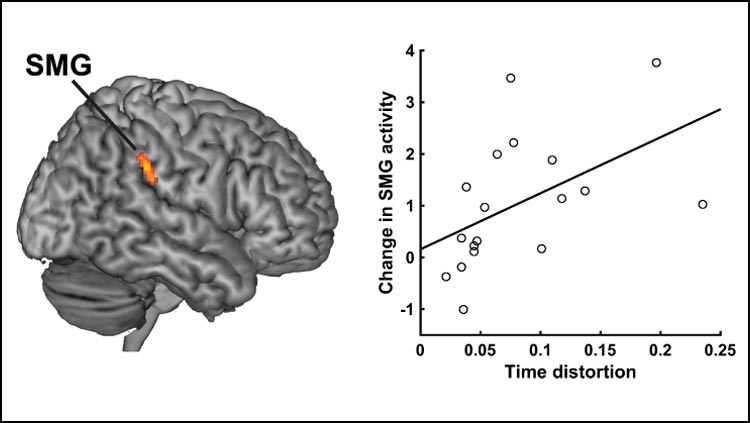
Neurons in the supramarginal gyrus (SMG) respond to specific time durations, but repetitive stimuli of the same length lead to neuron fatigue, causing a skewed perception of time.
Time-sensitive neurons fatigue and skew our perception of time.
On some days, time flies by, while on others it seems to drag on. A new study from JNeurosci reveals why: time-sensitive neurons get worn out and skew our perceptions of time.
Neurons in the supramarginal gyrus (SMG) fire in response to a specific length of time. If repeatedly exposed to a stimulus of a fixed duration, the neurons fatigue. Since other neurons continue firing normally, our subjective perception of time becomes skewed.

SMG that exhibited decrease in the activity following duration adaptation (left). Correlation between the magnitude of time distortion and the change in SMG activity (right). Credit: Hayashi and Ivry, JNeurosci 2020
Hayashi and Ivry measured brain activity with fMRI as human participants engaged in a time comparison task. Healthy adult participants viewed a visual adaptor (a grey circle) for a set length of time, 30 times in a row. After this adaptation period, they were shown a test stimulus and indicated its duration. If the adaptor duration was long, the participants underestimated time; if the adaptor duration was short, they overestimated time. Activity in the SMG decreased when the adaptor and test stimulus were similar in length, indicating neuron fatigue. The extent of skewed time perception correlated with how much the activity in the SMG decreased — greater fatigue led to greater time distortion.
Reference: “Duration-Selectivity in Right Parietal Cortex Reflects the Subjective Experience of Time” by 14 September 2020, Journal of Neuroscience.
DOI: 10.1523/JNEUROSCI.0078-20.2020









I wonder how they factored in the element of interest + time to/toward fatigue?
Maybe they didn’t due to fatigue………..loll (literally loll)
Deborah Wheeler Morales, good one!
I have been interested in the perception of time passing as it related to one particular experience I had. Riding down a local paved road that riders use to accustom young horses to payment and the rare truck we were surprised by a runaway beefalo bull. Part cow and part buffalo it was very large. Very large. And it was a pet and very spoiled. It was about 2 miles from home and the riders behind me shoosed it home again.
The time thing came up when Cheyenne, the horse I was on, exploded in 360 degrees. This is a phrase that means you have the impression of every muscle you are touching on the horse contracts and then releases without any net movement being achieved. However, the fact that he stopped abruptly and I did not, meant that I slid down his golden neck. I will never forget that long, long spell of time as I slowly drifted past his neck and on to the pavement. We were doing about 30mph at the time and I hit very hard. I broke 4 ribs and did not chase the beefalo back home. Nope, I had to chase myself home and it was a very long ride. Just getting back up with broken ribs was a feat of determination. I always wondered how it happens that time can slow or speed up without our apparent encouragement. Now I think I have a clue.
… The time flies when you trow the watch out of the window or one is approaching the speed of light.
However, I wonder how Quantum entanglement works. What is the mechanism that enables that mechanism to work its wonders. Could the time exist at that phenomenon, or it is a glitch.